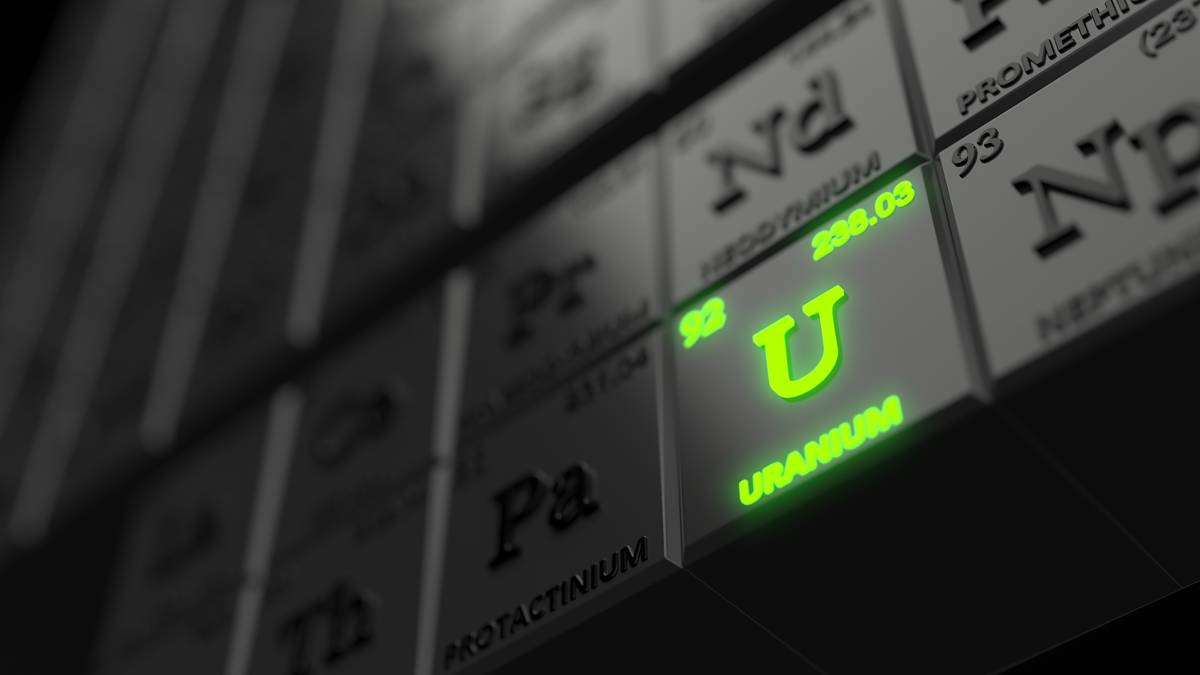Strategic reserves and supply shortages – uranium’s future glows brighter

Owners of US uranium deposits are in pole position if the Trump administration greenlights uranium purchases. Pic: Getty Images
- Trump Energy Secretary Chris Wright lobs call to grow US strategic uranium reserve, putting a rocket under yellowcake miners
- Comes after WNA ramped up 2040 demand forecast for future nuclear demand in latest fuel report
- American uranium miners and developers in pole position to benefit if US Government starts buying
Uranium prices have been locked in limbo, with term prices in the US$80/lb range for most of the past year and spot prices struggling to break above that mark.
That’s led to a lull in equity market sentiment for uranium stocks, delaying mine builds and stalling exploration from companies who need higher incentive prices to head into production.
But two key catalysts could thaw the frost.
The first is the release of the World Nuclear Association’s Nuclear Fuel Report at its latest symposium in London.
The updated figures suggest a raft of pledges from countries in North America, Europe and Asia to ramp up nuclear power capacity in a bid to combat carbon emissions and expand baseload power supply for modern technology like AI will amp up the demand outlook.
A base case reference scenario for nuclear capacity in 2040 has been lifted 9.5% to 686GWe on the WNA’s 2023 estimate. More on that later.
That shift in sentiment was supercharged on Monday night with the announcement by US Energy Secretary Chris Wright of plans to expand America’s strategic reserve of uranium in a bid to cut reliance on Russian pounds.
Its the latest in a long list of pro-uranium statements by the Trump administration, which wants to quadruple nuclear capacity to 400GW by 2050 and have 10 new large reactors under construction by 2030.
Russia is the primary source of enriched uranium to the USA, a major vulnerability for the American energy grid.
“We’re moving to a place – and we’re not there yet – to no longer use Russian enriched uranium,” Chris Wright told Bloomberg in Vienna, where he’s attending the International Atomic Energy Agency’s general conference.
“We hope to see rapid growth in uranium consumption in the US from both large reactors and small modular reactors.
“The size of that right buffer would grow with time. We need a lot of domestic uranium and enrichment capacity.”
A Section 232 Department of Commerce investigation into the status of imports of processed uranium and rare earth elements is ongoing and expected to report in October.
Chain reaction
The reaction to the statement was swift.
Canaccord Genuity analyst Katie Lachapelle said the news was “extremely positive” for US suppliers.
A strategic reserve was previously announced by Donald Trump in his first term, seeking to invest US$150m annually over 10 years – US$75m was authorised by Congress.
“This is extremely positive for US suppliers, noting that last time several producers received contract awards with pricing offered at a material premium to spot and term,” Lachapelle said in a note.
“Example: UEC won a $17.85M award to supply 300Klbs at US$59.50/lb to the DOE, when spot and term were approximately US$48/lb and US$51/lb.”
Key uranium ETFs ran around 10% higher overnight, with the spot price reported by TradeTech up US$1.50 to US$76.50/lb, Lachapelle noted.
ASX uranium stocks surged as well. Boss Energy (ASX:BOE) ran 7.3% higher, while Deep Yellow (ASX:DYL) rose 9% in morning trade and Silex Systems (ASX:SLX), which has an enrichment JV with Cameco in America, was up 8.5%.
Namibian producer Paladin Energy (ASX:PDN) didn’t trade after going dark for a $300m raising including a $231m institutional placement, intended to lock in funds for its second mine, Patterson Lake South in Canada, which it hopes to bring to market by 2031.
Raging (uranium) bull
Investors in US-focused uranium stocks certainly got the memo.
American Uranium (ASX:AMU), the junior explorer which owns the Lo Herma ISR resource in the major US uranium producing state of Wyoming was up close to 35% on Tuesday, with its NASDAQ listed investor Snow Lake Resources up more than 6.5%.
It’s one of the prospective producers which could see the benefit of a ramp up in purchasing for a strategic reserve. According to numbers tabled in a note by Argonaut’s George Ross, America’s uranium fuel reserves currently represent 14 months of requirements against 2.5 years for the EU’s reserve and 12 years in Chinese stockpiles.
The need to ramp up domestic yellowcake sources is stark. AMU MD Bruce Lane said the US was well short of its own needs.
“The US is the largest user of uranium in the world and currently consumes around 25% of total global demand but its domestic production is less than 2% of its annual 47Mlb requirement – this 47Mlb is before the projected tripling or quadrupling of US nuclear power being talked about by the US administration.”
AMU’s Lo Herma currently has an 8.57Mlb resource at 630ppm U3O8 with a 6-11Mlb exploration target beyond that, while its Great Divide Basin project hosts 1.66Mlb at a grade of 570ppm U3O8. With 37,500m of drilling in the pipeline, a mineral resource update is due at Lo Herma in Q4 2025, with a scoping study expected next year.
Other explorers are feeling the groundswell.
The US is now entering a period of ‘sustained, policy-backed growth’ for uranium demand, according to Pioneer Lithium (ASX:PLN) CEO Michael Beven.
Pioneer this year delivered a strategic pivot into both the US and Namibian uranium sectors, including the acquisition of the Skull Creek project in Colorado.
That site now has 17km of prospective strike with the Sego Sandstone, featuring strong anomalism from radiometric and geochemical surveys and rock chips grading up to 1240ppm U3O8. It is now aiming to progress those targets to drill-ready status.
“The outlook is very strong,” Beven said.
“US utilities are locking in multi-year contracts, and the government is now actively expanding a strategic uranium reserve to reduce dependence on foreign supply.
“Combined with targets to triple nuclear capacity by 2050 and rising power demand from electrification and data centres, North America is entering a period of sustained, policy-backed growth in uranium demand.”
Beven sees opportunities to deliver new supply as federal support piles in for domestic fuel supply, the development of advanced reactors and high-assay low-enriched uranium suited to smaller reactors.
“The challenges lie in permitting timelines and fuel-cycle bottlenecks, particularly enrichment and conversion capacity,” Beven said.
“But with the US actively funding solutions, explorers with scale, sound geology and strong ESG credentials, like Skull Creek, are well positioned to play a role in securing America’s future uranium supply.”
We don’t know where it’s coming from
When it comes to servicing the global demand quoted in the latest WNA Nuclear Fuel Report, the challenge is just as acute.
“Demand to 2040 on the reference scenario is around 150,000t of natural uranium which is just shy of 400 million pounds of U3O8,” says Guy Keller, the portfolio manager of Tribeca’s Nuclear Energy Opportunities Strategy.
“The supply response, 49% of that number, so 75,000t of uranium, is what they call unspecified supply.
“The WNA is sitting there saying, we really don’t know where that comes from.”
It’s clear prices need to scale higher to pull those ‘unspecified’ sources of supply out of the woodwork.
But contracting and the terms under which those contracts are signed has stagnated.
Up to the WNA symposium around 45Mlb of U3O8 had been contracted, contrasted to consumption for 2025 estimated at 180-190Mlb.
“That’s well below replacement value and well below the run rate of the last few years where contracting was starting to pick up again,” Keller said.
There could be issues down the line. Of the top 10 producing mines in the world just three are western, Cameco’s Cigar Lake and McCarthur River in Saskatchewan’s Athabasca Basin and BHP’s (ASX:BHP) Olympic Dam copper-gold mine in South Australia, an enviable situation for developers coming to market as the US and EU ramps up rhetoric around energy security.
Keller sees an impasse between utilities and developers, where power providers are unwilling to pay incentive pricing to underwrite development stage projects when the term price is in the low US$80/lb.
“There’s definitely a bit of chicken egg going on at the minute,” Keller said.
Conditions for a rebound
Uranium stocks have had a rough year, with ramp-up issues with brownfields developers chilling market expectations. Keller says investors could start coming back to the junior end of the sector if spot prices start to appreciate and contracting rates lift.
Its something Pioneer’s Beven says will be key to supporting developers at the junior end.
“It’s all about durable price signals. With term pricing around US$80/lb and now additional government demand through reserve purchases, the economics for advancing projects are increasingly robust,” he said.
“Stable pricing encourages explorers like us to accelerate drilling, permitting, and ultimately resource definition.”
It’s worth noting while uranium equities have been overlooked, tailwinds elsewhere in the nuclear fuel cycle show the nuclear thematic is not going away, with investors appreciating the role power-hungry AI data centres are playing in fuelling demand.
Nuclear, if not yet uranium stocks, is emerging as an investment thesis for institutions.
“That was something we identified in the fund beginning of last year when we hosted an investor lunch with Craig Scroggie of NextDC (ASX:NXT) and all the investor questions from some of these large instos were around data centre penetration,” Keller said.
“The obvious question is how do you power those? We have 40% of the fund now in what we call nuclear innovation because uranium had a massive drawdown, whereas that nuclear stuff really performed quite well.
“When you lift the hood on the fund performance last fiscal year, from the headline number, you see that nuclear innovation was a solid contributor all four quarters.”
At Stockhead, we tell it like it is. While American Uranium and Pioneer Lithium are Stockhead advertisers, they did not sponsor this article.

UNLOCK INSIGHTS
Discover the untold stories of emerging ASX stocks.
Daily news and expert analysis, it's free to subscribe.
By proceeding, you confirm you understand that we handle personal information in accordance with our Privacy Policy.








